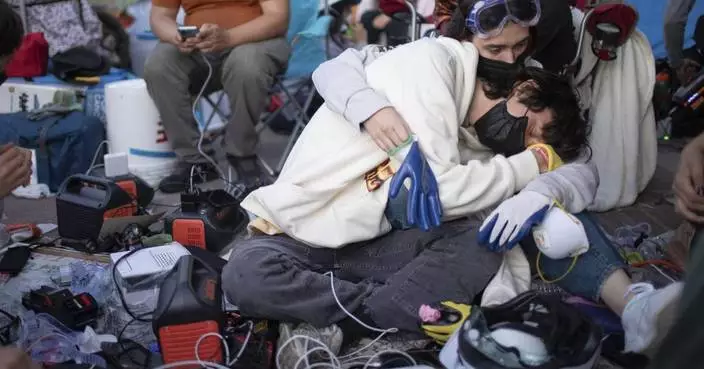SAN JOSE, Calif.--(BUSINESS WIRE)--Apr 23, 2024--
Edge Impulse, the leading platform for building, refining and deploying machine learning models to edge devices, has unveiled a novel technology for unlocking visual anomaly detection on any edge device, from NVIDIA GPUs to Arm MCUs, through the first model architecture of its kind: FOMO-AD (Faster Objects, More Objects - Anomaly Detection).
This press release features multimedia. View the full release here: https://www.businesswire.com/news/home/20240423080846/en/
The demand for edge-capable AI software has increased as a path to innovating factories and production lines, with on-device computing allowing faster access to critical data insights, low latency, and more robust security and privacy compliance.
Visual anomaly detection in particular is an important use case for industrial AI, but is not widely used as it requires creating a library of known anomalous samples to train the model to spot deviations in industrial environments. Companies cannot collect real-world samples for every anomaly, especially for unanticipated defects, limiting detection capabilities.
Edge Impulse’s FOMO-AD architecture, two years in development, offers the first widely accessible platform for visual anomaly detection on any edge device, from GPUs to MCUs. It is also the first scalable system capable of training models on an optimal state to detect and catalog anything outside that baseline as an anomaly in video and image data. This dramatically increases the productivity of visual inspection systems that will no longer have to be manually trained on anomalous samples before they can start generating real-time insights on-device.
“Virtually every industrial customer that wants to deploy computer vision really needs to know when something out of the ordinary happens,” said Jan Jongboom, co-founder and CTO at Edge Impulse. “Traditionally that’s been challenging with machine learning, as classification algorithms need examples of every potential fault state. FOMO-AD uniquely allows customers to build machine learning models by only providing ‘normal’ data.”
Most industrial camera systems capable of computer vision are powered by GPUs and CPUs, with a high install cost that requires wiring and a power-hungry connection to mains electricity. Recent advancements from top-of-the-line silicon manufacturers, and novel edge model architectures from companies like Edge Impulse, enable computer vision AI models to operate in either high- or low-power systems, giving businesses more choice. The benefits of low-power systems include the possibility of building battery-powered visual inspection systems, and lower production costs from using cost-effective hardware that can reduce the overall product form factor.
In recent months, Edge Impulse has been testing FOMO-AD with customers, achieving proven results in industrial environments when proactively detecting irregularities in multiple production scenarios. Use of FOMO-AD has led to marked improvements in machine performance and production line efficiencies for customers.
There are many manufacturing use cases for visual anomaly detection, including:
Edge Impulse’s FOMO-AD architecture is available to enterprise plan users today and compatible with all edge devices. Learn more about FOMO-AD in Edge Impulse’s documentation.
About Edge Impulse
Edge Impulse streamlines the creation of AI and machine learning models for edge hardware, allowing devices to make decisions and offer insight where data is gathered. Edge Impulse’s technology empowers developers to bring more AI products to market, and helps enterprise teams rapidly develop production-ready solutions in weeks instead of years. Powerful automations make it easier to build valuable datasets and develop advanced AI for edge devices from MCUs to CPUs to GPUs. Used by health and wearable organizations like Tunstall, Know Labs, and NOWATCH, industrial organizations like TKE and Lexmark, as well as top silicon vendors and over 100,000 developers, Edge Impulse has become the trusted ML platform for enterprises and developers alike. To learn more, visit edgeimpulse.com.


Model testing sample displaying testing output and results (Graphic: Business Wire)

Example of anomaly detection with found anomaly result displayed at the bottom (Graphic: Business Wire)
A wave of demonstrations has spread across U.S. campuses over the last two weeks, led by students who have pitched tents or occupied buildings in protest of the Israel-Hamas war.
It started April 18 when police moved to break up an encampment at Columbia University in New York City. Since then, it has spread to dozens of other campuses from Harvard to the University of California, Los Angeles.
Students are calling on their colleges to stop doing business with Israel or companies they say support the war in Gaza. Some also have asked for amnesty for student protesters who could face suspensions or other discipline.
University officials have negotiated deals with protesters at campuses including Northwestern University. Others have called the police to clear camps or campus buildings, as happened at UCLA.
At least 2,000 people have been arrested at campus protests nationwide in the last two weeks, according to a tally by The Associated Press.
Here are some questions readers sent to the AP, lightly edited for publication.
City and campus leaders in some places have alleged protests are being led by “outside agitators” with no connection to universities. Student protesters have rejected the claims. Those who are arrested often include a mix of students and non-students. Some claims about agitators have failed to hold up.
New York City Mayor Eric Adams alleged that “outside agitators” had co-opted the Columbia University demonstration before police officers came and arrested more than 100 people on Tuesday night. Adams referenced a woman whose husband was “convicted for terrorism.”
The woman he cited, Nahla Al-Arian, wasn’t on the campus, isn’t among those who were arrested and has not been accused of any crime.
The New York mayor has also noted many of the tents in the encampment were the same brand — more evidence of agitators, he said. Students who organized it said the tents were simply ordered in bulk.
Others have made similar claims elsewhere. After breaking up a demonstration at Northeastern University in Boston, campus officials said it had been “infiltrated by professional organizers.” Students denied it.
Pro-Palestinian activists are demanding that universities cut financial ties with Israel and companies that they say support it. Specific demands vary by campus.
On many campuses, students say they don’t know the extent of the campus ties with Israel. Yale is one of many campuses where students are demanding transparency around investments. The school doesn’t make all its investments public, and money can be hard to track after it goes to outside investment managers hired by colleges.
Activists in some places have identified specific ties they want to end. Students at the University of Michigan said the school sends billions of dollars to investment mangers that profit from the war. They cited investments in firms that produce drones and surveillance technology used in Israel.
Michigan officials said they have no direct investments with Israeli businesses and that direct investments make up a fraction of 1% of the $18 billion endowment.
Protesters at the Massachusetts Institute of Technology are also demanding an end to research contracts from Israel. They have published the names of researchers who accept money from Israel’s defense ministry for projects that they say help with drone navigation and missile protection.
As for the endgame, a big part of the protests is visibility — protesters say they want their message heard around the world. In that, they have succeeded, as demonstrations have led news coverage in areas including the Middle East.
It’s hard to know the exact percentage, but it’s relatively small. More than 2,000 people have been arrested across more than 30 colleges.
By comparison, the U.S. has about 6,000 colleges and universities, including all types of institutions. Those schools serve roughly 18 million students, including undergraduate and graduate students.
Protests have spread to dozens of campuses across the country but violence has been relatively rare.
The wave of protests is among the largest on U.S. campuses in recent history, but it’s still nowhere near as widespread or as violent as student demonstrations of the Vietnam War era.
Some historians say the movement might be the largest of the 21st century, but it doesn’t have a whole lot of competition.
And so far, the violence has paled in comparison to that of previous eras. There have been no bombings, for example, like the one in August 1970 at the University of Wisconsin that killed a researcher. And there has been no repeat of the infamous Kent State massacre.
Still, the movement has drawn comparisons to that era, especially with its roots at Columbia and its echoes of a 1968 protest in which students took over campus buildings to protest the Vietnam War.

A student encampment is shown at Middlebury College as they protest the Israel-Hamas war in Middlebury, Vt., on Thursday, May 2, 2024. (AP Photo/Lisa Rathke)













